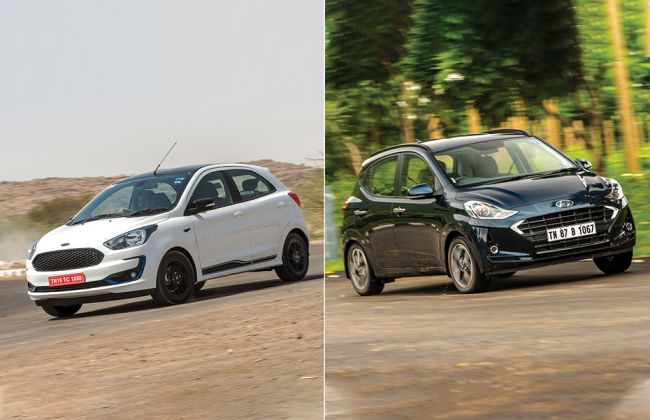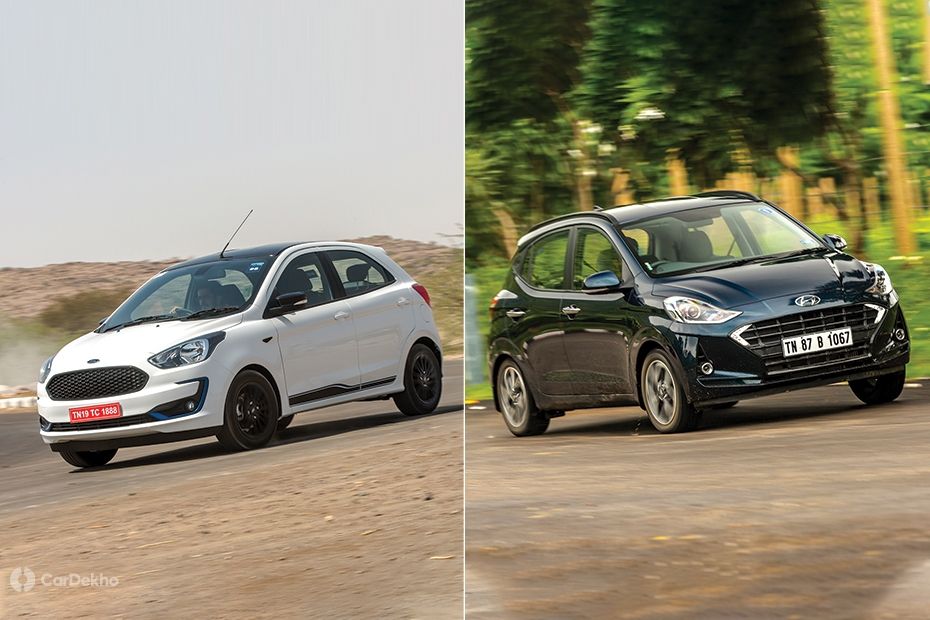Removing Holi Color Stains: Safely Reviving Your Car`s Shine Post-Festivities
- Thursday | 14th March, 2024
On the road without a net: Understanding bike insurance fines for driving without a valid policy
- Thursday | 8th February, 2024

Performance Comparison

The Grand i10 Nios is a hatchback that has improved on Hyundai’s formula of offering more features and better everyday usability than its rivals. Meanwhile, the Ford Figo enjoys a cult status among enthusiasts for being a driver’s car. Today, we pit these two together to find out which one offers better performance and fuel efficiency in the real world.
But before we dive into the details, let us take a look at the on-paper specs of the two engines. We shall be comparing the diesel-manual variants of the two cars as we have tested them independently.
|
Hyundai Grand i10 Nios |
Ford Figo |
|
|
Displacement |
1.2-litre |
1.5-litre |
|
Power |
75PS |
100PS |
|
Torque |
190Nm |
215Nm |
|
Transmission |
5-speed MT/AMT |
5-speed MT |
|
Claimed FE |
26.2kmpl |
25.5kmpl |
|
Emission Type |
BS4 |
BS4 |
On paper, the Figo has the Grand i10 Nios beat in terms of performance. The Figo’s larger displacement blatantly tips the scales in its favour. However, the Grand i10 Nios manages to claw a little bit of an advantage in terms of fuel efficiency, but the gap is not big enough to negate the performance factor.

So on paper, the Ford Figo is the better deal. But what happens when we test these two cars in real-world conditions? Find out below.
Acceleration and Roll-on Tests:
|
0-100kmph |
30-80kmph |
40-100kmph |
|
|
Hyundai Grand i10 Nios |
13.13s |
8.84s |
14.06s |
|
Ford Figo |
10.69s |
8.74s |
15.35s |
Owing to its larger engine and more power and torque output, the Figo wins the sprint from 0-100kmph. However, the story changes dramatically when it comes to the roll-on tests. The Grand i10 Nios is only a tenth-of-a-second behind the Figo when accelerating from 30-80kmph in third gear and manages to beat it by more than a second when accelerating from 40-100kmph in fourth gear.
This leads us to conclude that while the Figo should have a better top speed and better acceleration in a straight line from a stop, the Grand i10 Nios will provide better performance in everyday real-world driving conditions. However, the Figo is not that far behind.
Braking Distance:
|
100-0kmph |
80-0kmph |
|
|
Hyundai Grand i10 Nios |
42.62m |
26.48m |
|
Ford Figo |
41.95m |
26.80m |
The Figo offers better braking performance than the Hyundai, but only by a whisker. The braking distances of the two cars are so close that it would be unfair to pick a winner in this battle. So, let’s call it a tie.
Also Read: Maruti Swift vs Hyundai Grand i10 Nios vs Ford Figo vs Ford Freestyle: Space Comparison

|
Claimed (ARAI) |
Highway (Tested) |
City (Tested) |
|
|
Hyundai Grand i10 Nios |
26.2kmpl |
21.78kmpl |
19.39kmpl |
|
Ford Figo |
25.5kmpl |
25.79kmpl |
19.42kmpl |
The ARAI-certified fuel efficiency of the Hyundai Grand i10 Nios is better than that of the Ford Figo. However, in the real-world, the story is quite different. The Figo returns more kilometres to the litre both in the city as well as on the highway. And while the difference in the city can be termed as negligible, the Figo is miles ahead in terms of highway numbers.
If you’d like to see what kind of fuel efficiency you can expect from the two depending on your usage, take a look at the table below.
|
50% highway, 50% city |
25% highway, 75% city |
75% highway, 25% city |
|
|
Hyundai Grand i10 Nios |
20.52kmpl |
19.93kmpl |
21.13kmpl |
|
Ford Figo |
22.16kmpl |
20.7kmpl |
23.84kmpl |
Also Read: Hyundai Grand i10 Nios vs Maruti Suzuki Swift vs Ford Figo: Diesel Manual Comparison

While the factory numbers suggest that the Hyundai Grand i10 Nios offers better fuel efficiency while the Ford Figo offers better performance, the story is reversed in the real world. Yes, the Figo offers better performance in stop-and-go traffic, but it is the in-gear acceleration in third and fourth gears that matters the most, and that is where the Grand i10 Nios performs slightly better than the Ford. The shorter gearing of the Hyundai hatchback allows it to post better times than the Ford, despite being low on power.
And talking of fuel efficiency, the Ford’s ARAI-certified efficiency figure is less than that of the Hyundai Grand i10 Nios, but in the real world, it is the Figo that is more frugal. This difference, especially on the highway, is again down to the gearing of the two cars.

If you want a car predominantly for city driving, we’d recommend the Hyundai Grand i10 Nios in this case. However, if you hit the highway more frequently, then we’d suggest you opt for the Figo.
Read More on : Hyundai Grand i10 Nios AMT

Your support to NYOOOZ will help us to continue create and publish news for and from smaller cities, which also need equal voice as much as citizens living in bigger cities have through mainstream media organizations.
